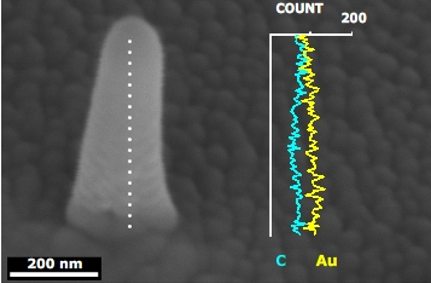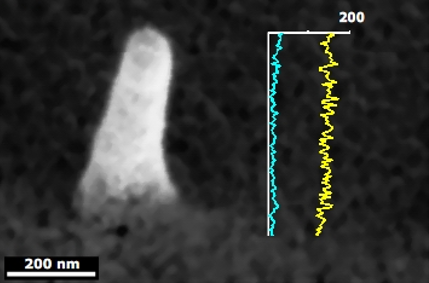IT-4-P-2152 Purification of FEBID gold nanostructures using oxygen plasma
Focused electron beam induced deposition (FEBID) is a mask-less, resist-less, direct writing technique where an electron beam is used to deposit patterned structures from precursor molecules in situ in a single process step. Noble metal nanostructures, especially Au nanostructures have received increasing attention due to their vast range of applications such as nano antennas, nanowire transistors and biomolecule devices. FEBID has already shown its potential for fabricating various shapes of Au nanostructures for different applications such as MOS capacitors, plasmonic structures. However, functionality of these structures are hampered due to the low metal content. To achieve a higher Au fraction in the FEBID Au material we investigated the influence of selected FEBID experimental parameters on the structure and composition of deposited structures. This work will present a technique to improve metal content on Au nanopillars and planar structures which can enhance the performance of different plasmonic and MOS transistor devices.
In order to explore the feasibility of nanoantenna, we have investigated free standing Au nanopillars (NPs). These NPs were deposited varying acceleration voltage, beam current and deposition time. A SEM EDX analysis showed a gradient of Au concentration along the height axis of NPs. Experimental results indicate that in situ electron beam induced curing occurred during deposition; which shows relatively higher Au content at the bottom sections of the NPs that suffered higher electron doses.
Furthermore, planar Au nanostructures were deposited following the same strategy as with Au NPs. The effect of point-to-point pitch, dwell time and acceleration voltage on the resulting structure was investigated. The EDX analysis revealed a horizontal Au gradient in the structures. A higher Au content was observed in the sections that received higher electron doses, which was consistent with the observed vertical Au gradient in free standing NPs.
A method using an oxygen plasma treatment was proposed to further increase the Au content in FEBID nanostructures. We show that a straight forward cleaning procedure can be applied for nanostructures deposited in both horizontal and vertical direction. The procedure increases the Au content while preserving the original shape and patterns of the structures.
In summary, this work will present an approach to improve the au content by choosing clever parameter combination in planar as well as free standing perpendicular Au nanostructures. The application of post-deposition cleaning technique will be discussed which might be useful for nanoplasmonics as well as other nanoelectronics applications.
Austrian Science Fund (FWF) Project "P24093- Crystal structure Preserving Electron-Beam Etching for Ge-Nanodevices" & USTEM, Vienna University of Technology.

